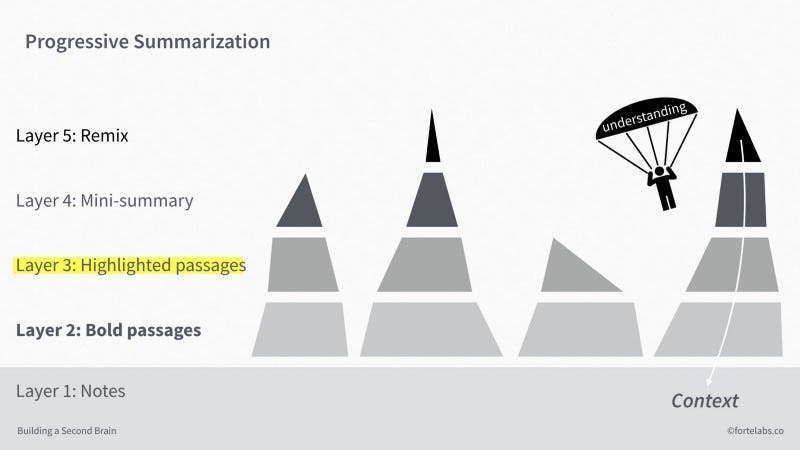Skip to content
 1.3 Practice
1.3 Practice
A. Practice Progressive Summarization
Practice doing progressive summarization on the text below.


Image of Progressive Summarization Layers from 0-5.
The text below in B. Designing Discoverable Notes is currently Layer 0 - which is the original text from the author. Take it to Layer 4, a mini-summary and put the mini-summary at the top of that section and change the color of the font to make it stand out (do that by highlighting the text and selecting the “red” A).
B. Designing Discoverable Notes by Tiago Forte
from
Summery Here:
A note-first approach to knowledge management means we have to think about design. You are, in a very real sense, designing a product for a demanding customer — Future You.
Future You doesn’t necessarily trust that everything Past You put into your notes is valuable. Future You is impatient and skeptical, demanding proof upfront that the time they spend reviewing notes will be worthwhile. You’ve gotta “sell them” on the idea of reviewing a given note, including all the stages any salesperson has to master: gaining attention, inspiring interest, establishing credibility, stoking desire, and making a case for action NOW.
As if all that wasn’t intimidating enough, you have to do this for every single note without spending any extra time. You don’t have extra time, do you?
Let’s start at the beginning: at the heart of every design, we are trying to balance priorities. You want one thing, but it has to be balanced against something else that you also want.
You want a vehicle to protect its occupants, but you can’t just add layers and layers of titanium armor plating. You have to balance safety against weight and cost.
You want a phone to have the longest possible battery life, but you can’t just give it a 10-pound brick of a battery. You have to balance battery life against size and usability.
In the case of notes, I believe the two priorities we are trying to balance are discoverability and understanding.
Making a note discoverable involves making it small, simple, and easy to digest. We accomplish this using compression: creating highly condensed summaries, without all the fluff.
But we also want to make our notes understandable. This involves including all the context: the details, the examples, and cited sources to be sure nothing falls through the cracks.
This is a difficult tradeoff because you cannot compress something without losing some of its context.
You cannot summarize an article without discarding most of its points. You cannot make a highlight reel of a video without cutting out most of the footage. You cannot give an 18-minute TED talk without leaving out most of your ideas.
In making decisions about what to keep, you are inevitably making decisions about what to throw away.
C. Next Steps
Write three key ideas that you takeaway from this exercise, the readings, and/or the video you’ve watched.
Next: 👉
Want to print your doc?
This is not the way.
This is not the way.

Try clicking the ⋯ next to your doc name or using a keyboard shortcut (
CtrlP
) instead.